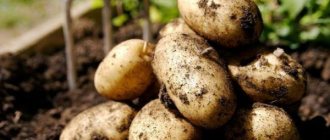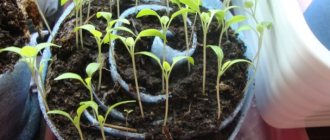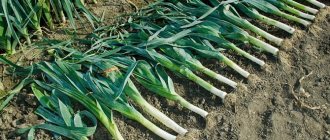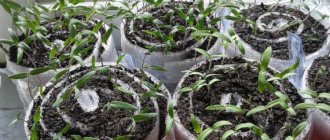The best eggplant varieties for growing in a greenhouse
Almost any eggplant can be grown in a greenhouse, but it is more rational to plant varieties with a short ripening period.
Eggplant varieties and hybrids suitable for greenhouses must meet the following requirements:
- gradual yield of the crop, long fruiting;
- early or mid-early ripening;
- good taste;
- high productivity;
- immunity to diseases and pests;
- height of bushes - from 70 cm.
Popular greenhouse varieties of eggplant:
- Bibo F1. Early hybrid. Reaches a height of 1 m. The fruits are white with excellent taste. Weight - up to 500 g. Resistant to fusarium rot and mosaic. From 1 sq. m harvest up to 4.8 kg of fruit.
- Alenka. Early ripening variety with green fruits. Weight – 350 g. Productivity – 7.5 kg per 1 sq. m. The variety is productive and disease resistant.
- Pink flamingo. Medium early ripening variety. The fruits are elongated, purple, weighing 250-450 g. The height of the bushes is up to 2 m. Productivity is up to 6 kg per 1 sq. m.
- Joker. Ultra-early tall variety. The fruits are small, weighing 100-130 g. The ovaries are collected in clusters, one bush produces up to a hundred fruits. Productivity – up to 8 kg per 1 sq. m.
- Viola di Firenze. High-yielding variety of Italian selection, medium ripening period. The fruits are oval-shaped, weighing up to 750 g. Does not tolerate temperature changes well. From 1 sq. m harvest up to 10 kg of fruit.
- Goliath F1. A tall hybrid of medium early ripening, reaching a height of 2.5 m. Fruit weight is more than 1 kg. The fruits have a classic appearance - pear-shaped, dark purple. From 1 sq. m harvest up to 9 kg of fruit.
- Maxik F1. An early hybrid, more than 1 m high. The fruits are pear-shaped, of a classic appearance. The bushes are compact, the fruits are small - they weigh 150-200 g. The yield is high - 10-14 kg per 1 sq. m.
- Boyar F1. Early hybrid. Fruits of a classic appearance, weighing up to 450 g. Productivity - 6.5 kg per 1 sq. m. Resistant to temperature changes. Requires stepsoning.
Which variety should I choose for home use?
Therefore, when choosing eggplant varieties for sowing, you should adhere to two rules:
- It is worth purchasing early varieties of this plant or their hybrids. This way the eggplant will ripen before the cold weather sets in.
- The seed must be able to withstand temperature changes and cold well.
The following varieties have proven themselves quite well: “Delicacy Gribovskaya 752”, “Dnistrovets”, “Rotunda”. They have time to fully ripen in a short summer, have good yields and a number of other positive qualities.
The video describes which eggplant varieties are suitable for the Urals:
Growing eggplants in the Urals
Our summer is short - it starts late and ends early. And eggplant is a heat-loving crop, so we grow it either in greenhouses or in greenhouses, under film. I prepare eggplant seeds for planting in early February.
I usually take early and mid-early varieties; others may not ripen in our country. To begin with, I disinfect the seeds in a pink solution of potassium permanganate for 20 minutes, then rinse with plain water and then soak for a couple of hours in a solution of the Baikal EM1 preparation. Next, I take out the seeds and place them in damp gauze or just a cloth.
I put the seeds in cloth in some shallow bowl or container and place them higher (I have them on the cabinet), where the temperature is quite high, about 30 degrees. The main thing is to make sure that the seeds are always moist. When the seeds hatch, I start planting.
I sow the seeds in ordinary large plastic glasses, in which the seedlings will “sit” until they are planted in the ground, since eggplants survive transplantation very poorly and after that they slow down their development. Don't forget to make holes in the bottom of the glass. I plant two seeds in each glass, just in case.
Later, if two plants have sprouted, one is weaker, I just carefully pull it out. Once every three weeks I feed the seedlings with complex mineral fertilizer (soluble) and spray it with an infusion of onion peels against spider mites. Since eggplants bloom when the day is short, I, To speed up fruiting for a couple of weeks, I use this technique: already in May, at six in the evening, I cover the seedlings with dark material that does not allow light to pass through, and in the morning I remove it. That is, I artificially shorten the daylight hours.
As a result, the seedlings I get are strong, stocky, not elongated, with a pair of flowers. As a result, the first harvest can be harvested already at the beginning of July. I plant my seedlings in greenhouses made of arcs with film stretched over them.
There is compost at the bottom of my greenhouse and a fertile layer of soil on top. The compost, overheating, heats the bed from below. When the threat of frost has passed, I change the film to a covering material. I plant the plants at a distance of about 40 cm, so the plants do not interfere with each other and develop freely.
I lower it into the hole until the first cotyledon leaves, sprinkle it with soil, water it with warm water and mulch a little more with dry soil. A little later, I mulch with hay or straw, so the soil under the eggplants remains moist for a long time. Further care consists of timely watering, opening the greenhouse for a day on hot summer days and fertilizing once every two weeks with an infusion of ash or phosphorus-potassium fertilizer. In extreme heat, I treat the plants with an infusion of onion peels. In July, I pinch off the tops and side shoots above the first and second leaves above the flower so that the set fruits ripen before the cold weather.
Care instructions after planting eggplants in open ground
For eggplants weakened by transplantation, night frosts are destructive. Therefore, at first, protection is required - a film stretched over arcs. It is completely removed only by mid-June.
Make sure that weeds do not spread in the eggplant bed - they darken the sun-loving crop and take away nutrients and water. Hilling is carried out periodically - this initiates the development of adventitious roots, which helps to increase productivity.
Watering
The first 2 weeks after transplantation, eggplants develop slowly. Plants do not need watering at this time - when the soil dries out, it is sprayed with a weak aqueous solution of urea.
Then the soil is kept moderately moist
It is important to prevent it from drying out and becoming waterlogged. This threatens poor-quality harvests and the development of fungal diseases.
Use only warm water: pour it into buckets in the morning and place it in a sunny area. After watering or heavy rain, be sure to loosen the eggplants in a timely manner. A dense earthen crust blocks the flow of air to the roots.
Top dressing
Throughout the season, eggplants require three feedings:
- 10 days after transplantation.
- 20 days after moving.
- By the beginning of fruit ripening.
I use traditional mineral fertilizers: potash, nitrogen, phosphate. In addition, I use organic matter: slurry, an aqueous solution of bird droppings.
Stepsoning
To reap a rich harvest, do not forget to carry out pinching regularly:
- The strongest and most powerful one is chosen as the main stem.
- Only fruits are left on weak branches - the shoots themselves are pinched.
- All shoots without ovaries are removed.
- To quickly ripen the crop, pinch the top of the bush a month before the end of the growing season.
For full development, three healthy strong stems are required, no more than 10 ovaries.
King of the North F1
This hybrid is rightfully included in the TOP of the best varieties for the Siberian region. It has virtually no flaws. The only negative is the impossibility of independently collecting seeds, since hybrids do not pass on their varietal qualities to the next generation. The variety has become popular not only in Siberia - gardeners in the middle zone are happy to grow it.
The variety is early, frost-resistant. The first fruits are harvested 105 days after the shoots appear. The hybrid is very productive - Siberians harvest up to 15 kg of eggplant per 1 sq. m. One plant produces about a dozen large fruits. Plants are of medium height, and in open ground they grow up to 0.5-0.7 cm, and in a greenhouse - up to 1 m. The lower fruits, touching the soil, can rot.
The fruits are uniform, elongated, small in diameter. They grow up to 30 cm in length. Eggplants can be straight or curved. Weight – up to 300 g. The classic color for eggplants is purple, and the flesh is white with a minimal amount of seeds. It has excellent taste.
Features of the variety:
- Able to tolerate minor frosts.
- It reacts poorly to heat, so it is not suitable for southern regions.
- Grown by seedlings. Moreover, seedlings can be planted directly in open ground.
- Tall bushes are tied up to prevent branches from breaking off under the weight of the fruit.
- Versatility - can be grown under or without shelters.
Basic principles of growth regulation
- Formation begins 14-15 days after planting in the greenhouse. The top is pinched at a height of 30-35 cm.
- All stepsons located below the first bud (flower) are removed. The flower itself is also removed.
- From the growing shoots, the strongest ones are always chosen, on which the harvest will be formed.
- The procedure is repeated on shoots of the second, and less often the third and fourth orders.
- All events are carried out at 2-3 week intervals.
The number of fruits is normalized according to the following scheme:
- for small-fruited (up to 250 g) varieties, rationing is not carried out;
- for medium-fruited (up to 450 g) eggplants, a third of the flowers are removed from each branch;
- in large-fruited plants (over 450 g), one largest ovary is left on each productive shoot.
Stepchildren and buds are plucked off at the very beginning of their formation to reduce the stress caused to the plants.
Advice! By normalizing the number of ovaries, instead of small eggplants, you can get a harvest of larger fruits if you reduce the number of buds. And vice versa, instead of heavyweights, small, neat fruits are obtained if the number of remaining ovaries is increased.
For beginning summer residents, growing eggplants in a risky farming zone—the Ural region—seems to be an unrealistic and unfeasible undertaking. But a competent approach to organizing the process, the correct choice of varieties and adherence to agricultural technology will lead to success.
Growing eggplants in open ground
Here, the conditions for growing eggplants are almost the same as in the previous case. However, there are some features unique to this method.
Preparing the bed. It is better to provide a bed for the “little blue ones” in a sunny, sheltered from the wind place, previously cleared of weeds. It is better if the site has sandy loam or light loamy soils. In other cases it is necessary:
- Add humus mixed with turf soil into the peat soil;
- For heavier soils, you need to add peat, humus, straw cuttings, river sand or sawdust.
- If the soil is sandy, add peat, clay soil and sawdust.
As with growing eggplants in a greenhouse, it is advisable to start preparing the bed in the fall. Its width should be no more than 1 m. Determine the length of the bed at your discretion. Next, the selected area needs to be dug up (25-30 cm deep), adding fertilizers with all the necessary components (urea, superphosphate, potassium sulfate) and removing weeds.
In April, the bed should be leveled with a rake, destroying pest larvae and remaining weeds, and watered with Effekton fertilizer or hot mullein solution.
Planting in open ground. Eggplants are usually planted in seedlings and without seedlings. In the first case, this is done when the frosts have passed and warm weather has set in (the first ten days of June). The process of planting seedlings is the same as when growing “little blue ones” in a greenhouse.
With the seedless method, sprouted and slightly dried seeds are sown in the ground in mid-May (after the top layer has warmed up to +15°C). Since eggplants grow slowly in the initial period, radishes are sown along with them. This will help you avoid losing rows of plants.
Since this crop is afraid of night cold, it is necessary to stretch a protective film on wire arches over the beds. It will be possible to remove it in early June, when warm weather sets in.
Caring for eggplants in the beds. To create the most favorable conditions for growing eggplants in open ground, you need to carefully and regularly care for the plants. To do this, follow these simple tips:
- During the summer, loosen the soil as often as possible (especially after rain), without allowing it to become compacted. This will give the roots more air and help the seedlings grow more actively.
- Water the garden bed generously (follow the recommendations described in the first part of the article).
- Hill up the plants after watering. This will promote the development of adventitious roots and increase the yield of eggplants.
- Remove weeds promptly.
- Make three feedings with bird droppings, or slurry and mineral fertilizers. The first feeding should be carried out 10 days after planting the vegetable crop, the second - after about twenty days, and the third - at the beginning of fruiting.
- Make sure that diseases and pests do not appear on the “little blue ones”.
In both the first and second cases, the harvest can be harvested when the fruits acquire a color characteristic of their variety and become glossy. This usually occurs 30-40 days after the start of flowering. Vegetables are cut with pruning shears or a knife along with the stalk, and stored in a dry, cool place for no longer than one month.
Category: Garden and vegetable garden.
Harvest and storage
Eggplant fruits in the Urals are ready for harvest no earlier than August. In ideal summer weather, in open ground you can collect no more than 5–7 fruits from a bush, and in a greenhouse only some varieties will produce more. Eggplants are harvested in the technical maturity phase: they must grow to the size characteristic of the variety, acquire the desired color, and gain fleshy edible pulp. Seeds in the technical ripeness phase are still white, soft to the touch, and completely unripe. The harvest must be harvested weekly; it is better to cut the fruits with pruning shears, along with the stalk. Overripe eggplants are only suitable for seeds.
Eggplants are stored for a very short time: this period rarely reaches a month. They should be stored together with the stalks, the optimal temperature is 1–2 °C, relative humidity 85–90%. Since it is difficult to store them, they try to process the fruits in the very first days after picking.
Video: harvesting eggplants
In the Urals, summer is very short, it is completely insufficient for growing eggplants in open ground. However, greenhouse cultivation most often leads to guaranteed success. But even in greenhouses, mostly early-ripening varieties and hybrids are planted, and even greenhouse cultivation requires a lot of effort and effort.
- Author: Semyon Vladimirov
Rate this article:
- 5
- 4
- 3
- 2
- 1
(0 votes, average: 0 out of 5)
Share with your friends!
Eggplant care
Timing for planting seedlings in open ground:
- in the southern regions of Russia - late April - early May;
- in central Russia, as well as in Belarus - late May - early June;
- in the Far East, the Urals and Siberia - early - mid-June.
It is difficult to give exact dates for planting eggplants, because they also largely depend on the weather conditions of a particular season. The “blue” seedlings should be planted when the soil at a depth of 10 cm warms up to 15°C.
Plants should be replanted to a permanent location with extreme caution so as not to damage the roots. That is why it is best to lower the seedlings into the holes, which should be slightly larger than the seedling pots, directly with a lump of earth
The distance between holes should be at least 70 cm, and between rows - about 50 cm.
Before planting eggplants, pour a little hot water into each hole, and if the soil on the site is not very fertile, then add fertilizer: a handful of humus or compost, ¼ tsp. superphosphate and 1 tbsp. ash.
Eggplant seedlings should be planted vertically and at the same depth at which they grew in separate containers. Otherwise, the plants may not take root. It is recommended to immediately install pegs about 60 cm high next to each specimen. After the seedlings are planted, they must be compacted by hand, watered and mulched with peat or humus.
In order for eggplants to grow to your delight and to the envy of your neighbors, it is not enough just to plant the seedlings in the ground - you still need to properly care for them. For example, the soil around young plants should be regularly loosened and weeds removed in a timely manner. Eggplants need to be watered frequently, but this should only be done in the morning or evening.
On hot days, plants need to be shaded from the scorching sun. To do this, you can stretch a dark fabric over the bed or drive pegs around the perimeter of the bed and place a plywood sheet on them. But remember that the crop needs shade only in the heat and in an open place.
In general, eggplants are a rather heat-loving crop. Therefore, if the nights are still cool in spring, the plants should be covered with film or non-woven material. This will protect them from hypothermia, which means it will preserve the future harvest.
Growing seedlings
To grow eggplants in the Urals, you need to make a lot of effort. Compared to preparing tomato or pepper seedlings, this crop is more demanding on soil and growing conditions.
Sowing time for seedlings
To obtain relatively fast seedlings in the Urals, seed material should be properly prepared. The first shoots appear after 7-8 days, and the next ones after 10-15 days. Vegetable growers begin preparatory work in the winter - in the last days of February. These temporary indicators do not affect the method of cultivation: plants will be planted in open or closed ground. Taking into account the peculiarities of the climate in the Urals, young seedlings are planted in early summer, and in a greenhouse or greenhouse - towards the end of May.
Subtleties of care
The seeds are sown in peat or other cups filled with a prepared soil mixture of peat and garden soil (1:1) with the addition of 10% sand, and placed on a windowsill where there is sufficient sunlight. The air temperature in the room before emergence should be 16-18 degrees, then it is raised to 23-25 degrees and maintained until the seedlings can be planted in a permanent place.
When growing in the Urals, watering should be organized 1-2 times a week. Warm water temperature is 30-32 degrees. Excessive humidity in containers should not be allowed, otherwise there is a high probability of the development of putrefactive processes in the form of a disease such as black leg. To strengthen young plants, you need to add a fertilizer mixture of nitrogen agrochemical (1 tbsp) and water (10 l) 12-14 days after the sprouts appear.
Since friendly shoots are not observed here, transshipment into large containers should be done selectively. It is advisable to remove the plant along with a lump of earth in order to keep the eggplant’s still fragile root system intact. The volume of the pot for transplantation should be within 1 liter. When transferring seedlings, you should not deepen them too much, as an exception - only elongated plants can be planted somewhat deeper.
Hardening of young seedlings in the Urals is carried out 2-3 weeks before planting in a permanent place. They are placed on the balcony, gradually increasing the duration of the procedure. Abundant watering is required before planting in the ground. The recommended height of seedlings for planting is 20-25 cm, the number of large leaves is from 5 to 8 pieces.
Dates for planting in the greenhouse
Eggplants are transplanted into a heated greenhouse structure in the Urals in early May, and into a regular greenhouse no earlier than the 20th. If there is a lack of heat, it is recommended to additionally cover the seedlings with non-woven material. If you plan to plant seedlings in an open area, you should do this in mid-June, and the ground should be sufficiently warm.
You can’t do without spunbond or polyethylene here either. The site is equipped with arcs and covering material, the film is removed at the end of June and only during the day.
Planting seedlings and subsequent care
Greenhouse eggplants in the Urals also need constant care, like those that grow in open areas. For their growth and development, sufficient light and heat are required; the temperature in the greenhouse should be maintained at 25-30 degrees. During the day, be sure to open the windows if it gets too hot inside. Good ventilation prevents plants from getting sick.
Irrigation inside a greenhouse or greenhouse should be carried out more often than in open ground. When the bushes reach a height of 30 cm, the top of the main stem must be pinched to ensure the growth of side shoots (4-5 pieces). You also need to monitor the condition of the leaves; yellowed and excess leaves that cover the fruits must be removed. Only with enough light are eggplants able to fully ripen.
If there is a high level of humidity in the greenhouse, additional pollination should be taken care of. It is performed using a brush, transferring pollen from one plant to another.
Planting care
Eggplants after transplanting initially grow very slowly, growth resumes only after two weeks. During these two weeks, you just need to make sure that the soil is slightly moist and loose. Subsequent care includes watering, fertilizing, loosening and shaping the bushes.
Eggplants in open ground
Why were large pots needed for seedlings? It’s good if there is enough space to keep it at home for three months, until the buds are set. Then there will be a greater chance that in the open ground there will be a normal harvest. It is possible to remove film from arcs in the Urals only in July. From the second half of June, eggplants open during the day, but return to cover at night. And in August the weather may become colder again, and the plants will again require wrapping: not permanently, but with a clear drop in temperature.
Film in the Urals is never removed far
Watering is required constantly: the soil in the eggplant bed should always be slightly moist. Be sure to water it with water heated in the sun, at the root. Until the buds bloom, the bed is watered once a week: in the morning or evening, spending about a bucket of water per 1 m2. After the flowers bloom, you need to water more often. After each watering or rain, loosening is carried out, accompanied by the destruction of weeds.
Hilling of eggplants is not used in the Urals. No fertilizing is carried out until fruit set, but then they are given twice a month. Initially, infusions of mullein or bird droppings are used, and during the period of intensive fruit growth there is no need to provide nitrogen, so only superphosphate and potassium sulfate are used. You can replace mineral fertilizers with an infusion of wood ash.
They do not form bushes in open ground in the Ural region. True, when the plants reach 40 cm, they pinch off the top. After this, they only normalize the number of ovaries, leaving no more than 5–6 of the largest specimens on the bush. After removing excess ovaries, all newly formed flowers are also torn off. The leaves that protect the fruit from the sun are torn off.
Eggplants in a greenhouse
Eggplants in the Urals require tireless care in the greenhouse: even in protected soil, the success of the event depends on the current weather. Eggplants need sunlight and real, consistent heat. Sunlight should be maximum, and the temperature inside the greenhouse should be about 25–30 °C, with almost no daily fluctuations. And if in case of hot weather you can easily maintain the temperature in the greenhouse by simply opening the window and doors, then you still have to close them at night.
In a greenhouse, watering is needed more frequently than outside. The feeding regime does not differ from that when growing in open ground, but the formation of bushes is mandatory. When the eggplants grow to a height of 30 cm, the top of the main stem is pinched, and then the side shoots begin to grow. You can leave 4-5 of them. Be sure to remove all yellowing leaves, as well as leaves that block the fruit from light.
In a greenhouse, it is especially important to expose the fruits and give them as much light as possible.
In a greenhouse, additional artificial pollination of flowers is also desirable, which is carried out by transferring pollen from one flower to another with a brush. This procedure is especially important if the humidity in the greenhouse is too high.
Methods and technologies for regulating growth and fruiting
The formation of bushes is carried out in order to increase the yield. Proper shaping of the bush increases the number of ovaries and also allows you to adjust the weight of the fruit. Low-growing and dwarf varieties are allowed to grow without molding. Medium and tall plants need regulation.
They do not form bushes in unprotected beds; they only pinch the crown when the height of the bush reaches 40 cm. Then the number of ovaries is normalized: 5-6 of the largest fruits are left on each bush. New flowers are also plucked off; the prospect of getting a harvest from them is negligible, but they will take away the strength of the plant.
Advice! To ensure that eggplants ripen evenly, the leaves that shade the fruit are removed.
Methods of formation and the appropriateness of their use for eggplants in a greenhouse are determined primarily by the condition of the plant:
- Weakened seedlings are formed into 1 stem when they are thickened or when there is insufficient illumination of the internal parts of the bush.
- Bushes with 2 or 3 or more stems can be grown with sparse planting, when they are not crowded, lighting and air access are not limited in any way.
Summer residents who do not have the opportunity to visit the site every day prefer to grow low-growing varieties, since the formation of a bush is a process that requires constant monitoring.
How to grow eggplants in open ground in the Urals?
To get a good harvest of eggplants in the difficult climatic conditions of the Ural region, you need to work hard.
In addition to harsh weather conditions, gardeners face another danger: insect pests.
Eggplant can be attacked by spider mites, Colorado potato beetles and other pests that eat nightshade crops. You can fight aphids, mites and thrips by washing them off with soap and water, but it will be more effective to use the Barrier preparation.
The remedy “Prestige” is used effectively for the Colorado potato beetle. Since eggplant seedlings are still grown in greenhouses, they are, among other things, at risk from greenhouse whitefly, and the drug “Confidor” has been successfully used against it for many years.
Most modern varieties and hybrids of eggplant, especially for regions with low temperatures, have good resistance to diseases, including fungal ones. But this does not mean that owners of summer cottages can relax; no one has canceled prevention.
Timely watering, abundant but not frequent, good lighting and low planting density is the first step to healthy plants and a good harvest. But anything can happen on the site. If your plantings are affected by root rot, you need to reduce watering.
Blackleg is an incurable disease that threatens to spread to other plants. To avoid this, the affected bushes are removed, and the places where they grew are treated with a disinfecting solution. Unfortunately, only such radical measures can prevent the spread of the disease to other bushes.
It should be watered with slightly warm water every 10-12 days, but generously. The water should be passed through a filter or allowed to stand for 24 hours. Feeding should be carried out 3-4 times per season. It is better to use complex fertilizers.
Such products as “Zdraven”, “Kemira-hydro”, “Kemira-combi” are suitable for this.
In addition, to provide eggplant bushes with microelements, fertilizing with such preparations as “Zircon+” and “Tsitovit” should be carried out every 25-30 days. This will fully meet the plant’s needs for all necessary substances.
Eggplant bushes require a mandatory garter, and its branches should be strengthened with supports, since the fruits can be quite large, which can cause them to break off. When the plant reaches 30-45 cm in height, it can be pinched, leaving no more than 6 ovaries.
Fortunately, there are varieties that can be grown in open ground in the Urals. This is not the easiest thing, but if you put in the effort, everything will work out, for sure. Good luck to you and have a great harvest.
NOTE! Find out what diseases eggplants are susceptible to: what to do if the seedlings fall, stretch out or completely die? Causes of white spots, yellowing and curling of leaves. And also what pests can attack young seedlings?
Pest and disease control
The thin, tender leaves of eggplants attract a significant number of pests. As a preventative measure, it is better to use dusting with wood ash - it repels most parasites and helps prevent many diseases.
- Aphids - infusions of tansy, wormwood, capsicum, soap solutions (green or for pets). To deter them, spicy celery, dill, calendula, and marigolds are planted next to the main crop.
- Colorado potato beetle - pre-planting soil treatment with Actofit, spraying with infusions of hot pepper, wormwood, repellent and other pests. In the greenhouse, Fitoverm or other bioinsecticides are used; in open ground, chemicals can be used, but only as a last resort.
- Spider mites - for prevention, regularly spray with infusions of onions, garlic, hot peppers, tomato or potato tops, and ammonia. It is recommended to plant onions, garlic, calendula, and marigolds in the row spaces as a green barrier.
Note! In case of mass infestation of the little blue ones by the pest, acaricides are used - “Vermitek”, “Neoron”, “Nissoran”, etc. Conventional insecticides are powerless.
- Squirrel moth - adults are lured into traps or vacuumed up. To combat larvae living in the soil, insecticides are used - “Confidor”, “Fufanon”.
- Pathogenic viruses, bacteria and fungi cause severe diseases, leading to the loss of 70% of the crop.
The main means of combating viruses is strict adherence to agricultural technology, especially in greenhouse conditions, soil cultivation in the fall and spring, and disinfection of seed material. As a preventive measure, the soil is treated in spring and autumn with Bordeaux mixture, copper sulfate or pink potassium permanganate.
Fitosporin, Trichodermin, and Baktofit cope well with fungal infections of eggplants. The best preventative agents include copper sulfate or Bordeaux mixture, which is used to treat the grant twice a season. “Farmayod” is effective for treating greenhouses, destroying the vast majority of pathogens.
Know! There are no means of combating diseases of bacterial or viral origin; preventive measures include adherence to agricultural practices, pest and weed control.
Methods for forming an eggplant bush
There are several known methods for forming an eggplant crown, these are the so-called pruning techniques into one, two, three stems or more. This approach makes it possible to form an elegant crown, depending on the physiological characteristics of each individual variety, and also to achieve rapid ripening of the crop
At the same time, the procedure should be approached with caution; it is necessary to evaluate the condition of the plantings, since radical pruning of weak plants always leads to their death
In one stem
Pruning a bush to one stem is considered the most radical way to shape eggplants, but this is often a necessary measure.
In most cases, the following reasons lead to this:
weakening of plants due to poor rooting or unfavorable conditions
In this case, it is possible to direct all efforts to the formation of fruits, which often does not happen without pruning;
dense plantings - one stem helps prevent a lack of free space on the site, which is especially important for tall varieties;
lack of lighting - in this case, pruning helps the fruits to ripen well during the active growing season, as well as to avoid shading of neighboring plants, which is always fraught with inhibition of the growth of both
The formation of a single stem on the bush begins within two weeks after transplanting the eggplant seedlings to a permanent place. If the plant is weakened, it is permissible to carry out the first pruning with a delay of up to 1 week. Regardless of the moment of the first formation, the procedure is subsequently repeated at intervals of 2-3 weeks, until the technical ripeness of the fruit.
Forming an eggplant bush to one stem involves the following measures:
- In the root zone of the stem up to 5 leaves, all side shoots and ovaries are removed.
- In the zone of 6–8 leaves, cut off half of the ovaries and pinch out all the stepsons.
- On about the 10th leaf, pinch off all the shoots after the first leaf with the ovary.
- After 10 leaves on the stem, shoots with an ovary on two leaves are left, while no more than 3 leaves are allowed to be kept at the top.
In two stems
Formation into two stems involves the creation of an elongated trunk, at the top of which a crown with fruits will develop. As in the previous option, depending on the condition of the plants, this procedure begins 14–21 days after planting the seedlings in open soil.
Important! When pruning a bush, you must definitely pay attention to its shadow; it should not shade the leaves, shoots and future ovary, as well as neighboring plants.
This pruning is done as follows:
- After the plant reaches 35 cm, the top is pinched, this activates additional buds and promotes the growth of side shoots.
- After 1-2 weeks, all lateral branches on the bush are cut off, leaving only the 2 most viable ones. In this case, any side shoots developing below the 2 side shoots are also subject to removal. It is allowed to leave 2-3 lower leaves shading the near-trunk ring of soil, this will protect the substrate from excessive evaporation of moisture.
- In the future, pruning is carried out every 2-3 weeks, any additional lateral shoots are subject to pruning, as well as excess leaves, shoots developing on 2 lateral stepsons. As the ovary appears, it is thinned out, and their number must be gradually increased from the bottom to the top.
Three stems (or more)
Trimming to three stems is considered the most popular. In addition to the fact that it makes it possible to form a dense crown, only in this case can you achieve increased productivity from the plant. However, it is not always useful; it is used only in the case of free planting of eggplant, as well as to fill the free space of the greenhouse; in dense plantings it will lead to oppression of the eggplant.
Such formations are carried out using the following successive steps:
- After the seedlings have lengthened to 30–35 cm, pinch off the top.
- After 1–3 weeks, all side shoots are removed from the bush, leaving only the 2 most viable ones.
- After another 2 weeks, additional shoots begin to form. To do this, leave 1 stepson on each of the main ones, which are pinched after the 2nd leaf, without removing the ovaries. Shoots without ovaries, as well as excess foliage, are also subject to removal.
- About 30 days before the expected harvest date, all growth points on the bushes are pinched, this promotes more active growth and ripening of the fruits.
Forming
Even when choosing low-growing varieties for cultivation, the gardener has to intervene in the formation of bushes:
- All stepsons are plucked from the bottom to the first bud;
- the lower leaves lying on the ground are also cut off;
- to stimulate branching, pinch the crown if a fork does not appear 30-35 cm from the ground;
Tall bushes are tied up like tomatoes to prevent the shoots from falling.
A resident of the Moscow region tells how to remove shoots and maintain the resilience of plants after a stressful intervention in a video on the topic:
Eggplant seedlings - when to plant in the Urals
The first thing I wanted to cover was the topic of how to plant seedlings in the Urals, given their harsh climate. And the whimsical nature of such a vegetable is not pleasing, but I really want to enjoy delicious eggplants. It doesn’t matter, you can always find a way out
There are special and even hybrid vegetable seeds that are suitable for any climate. These are the ones we will talk about today. And the choice is always yours
Sometimes you can get confused when choosing seeds; I offer you a few more well-known ones, those that are in demand among gardeners. Varieties - Nadir, Negus, Rotunda, Violet miracle, there are still a lot of them.
It is, of course, best to grow seedlings under a film, this will give you a guarantee that the already heat-loving plant will sprout much faster if sowed correctly.
The first thing you need to start with is choosing the right date for planting the seedlings. As many gardeners do according to the lunar calendar, I suggest you familiarize yourself with these dates below
The most favorable days for this vegetable crop
- in February – 1, 2, 3, 7, 8, 11-13, 16, 17, 24, 25
- in March – 10, 11, 12, 15, 16, 23, 24
- in April – 7, 8, 11, 12, 20, 21
Unfavorable days for planting seeds for seedlings
- in February - 19 - full moon, 4-6 - new moon
- in March - 5, 6, 7 - new moon; full moon - March 21
- in April - 4, 5, 6 - new moon; full moon - April 19
Next we need to prepare the seeds; for this we purchase the variety that you decide to plant. We take a small cloth, soak it with water and place our prepared seeds in it. Cover the top with the same cloth and leave for a short time in a warm place. If you see that your fabric has dried out, wet it again; this procedure must be repeated until the sprouted seeds appear. This way we can select the “dummies” and plant only the right seeds with borings that will definitely bear fruit
Next you need to prepare the soil. You can buy it in the store, or you can plant it in your own previously prepared soil. A prerequisite is the lightness of the soil and when planting, the temperature of the ground should be room temperature, but not cold.
Since this vegetable is very capricious, when planting, use dishes that do not require picking up eggplants, such as peat or plastic cups. So that you can plant two seeds one at a time in one pot. For example, if you stuck two seeds into one pot and saw that they both sprouted, very carefully remove one of the sprouts and leave the stronger one
This method does not require further picking, which in our case is important
We sow our ripened seeds into the prepared soil, lightly cover them with soil and pat them with our palm, lightly compacting them. Before planting grain, make sure the soil is firm. So that the next watering does not cause the earth to collapse. Cover the sown seeds with film and leave them in a warm place, with little exposure to warm light rays. If necessary, remove excess condensation from the film
The average ripening speed of such varieties for the Urals reaches from 75-100 days, counting from the first day of the appearance of the first sprouts, mid-ripening ones ripen by 110-130 days.
So, despite the short summer, residents of the Urals will be able to enjoy their eggplants. When taking care of seedlings in advance, it is advisable to choose early or mid-ripening varieties; hybrid ones are also suitable. Plant for fun.
We plant
In greenhouses, the ground warms up much earlier, so summer residents have time to prepare the soil when the snow outside the walls of the structure is still melting. But you can’t rush to plant seedlings. These little blue ones are too heat-loving crops. In terms of timing, the picture is something like this:
- in the Moscow region, according to the weather, May is suitable for planting;
- in Siberia, before June, eggplants are comfortable only in heated greenhouses, and ordinary summer residents take out seedlings in the first days of summer;
- in the southern Urals they manage to land by the end of May, and in the north they are guided by Siberian deadlines;
- the southern regions begin to replant eggplants in greenhouses from February-March (Crimea), March-April (Stavropol region, Krasnodar).
It is important that the soil in the greenhouse is already warmed up to at least 15 degrees. The seedlings are not afraid of night frosts - we are in the house
The distance between the holes depends on the size of the bushes. Therefore, we carefully read the characteristics of the variety. On average, it is recommended to plant no closer than 40x40 cm, and make row spacing up to 60 cm, especially if the bushes promise to be large. The technology for planting eggplant seedlings is not so difficult as to frighten a beginner.
But a novice eggplant grower should thoroughly familiarize himself with the agricultural technology of the blue-sided vegetable.











